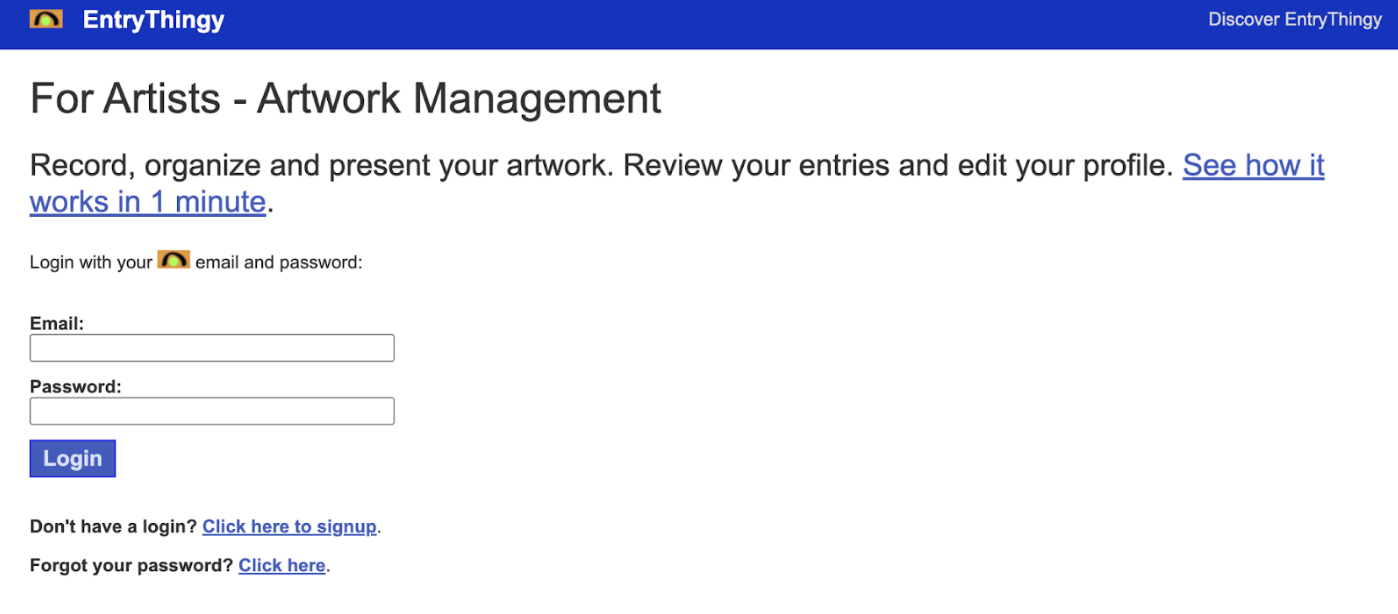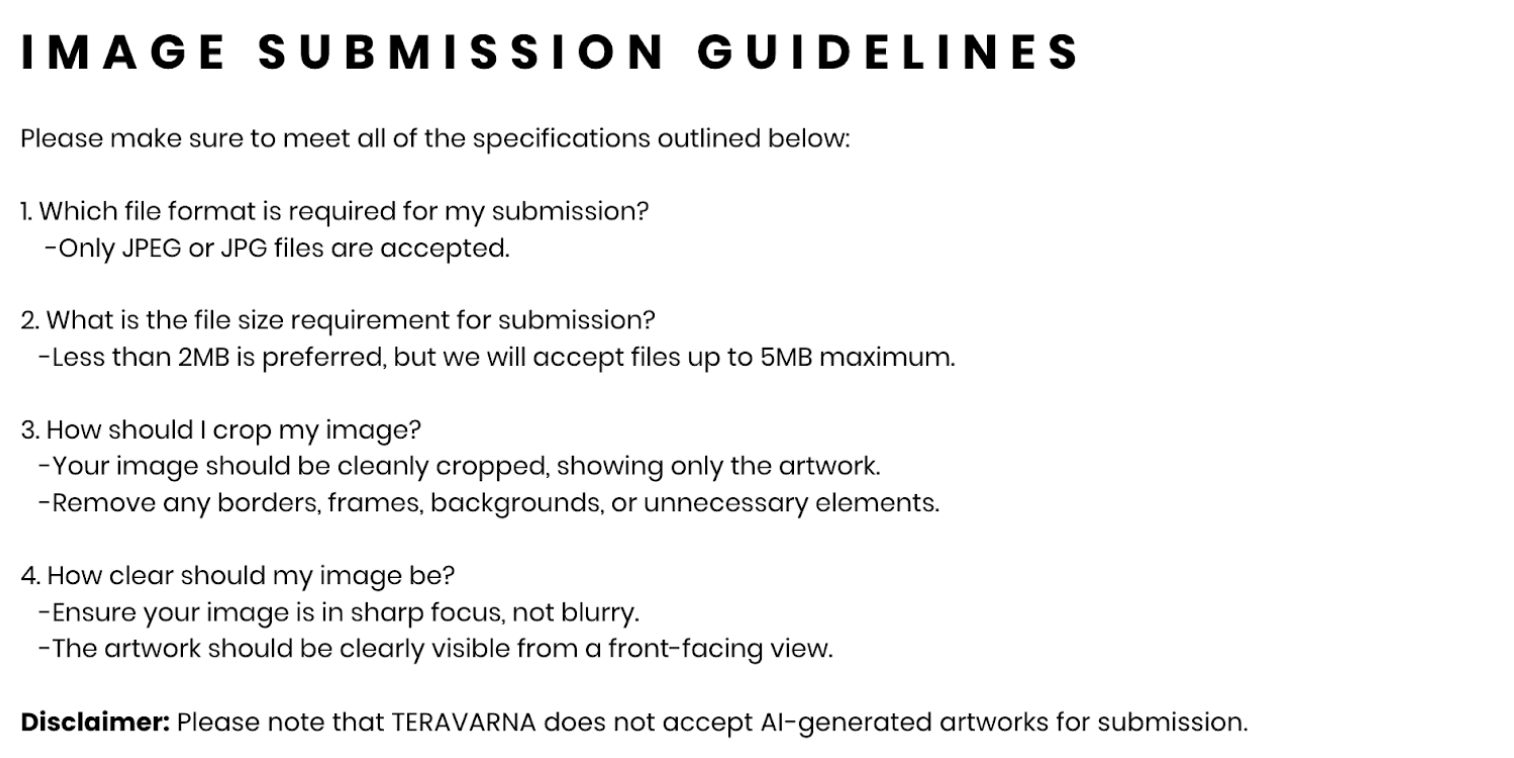Every exhibition starts with one step: applying with your work.
Calls for art are open invitations from galleries, museums, and organizations looking for new artists to feature.
They’re one of the best ways to get your work seen by jurors, curators, and collectors who can help your career grow.
If you’ve ever tried managing applications through email or spreadsheets, you know how messy it can get.
That’s why most art organizations now use online platforms like EntryThingy, where you can upload your artwork, pay fees, and track everything in one simple dashboard.
In this guide, you’ll learn how to find the right call for art, prepare your work, and apply successfully using EntryThingy.
TL;DR: 9 Steps to Apply for a Call for Art
1. Find the right call for art – Look for open calls for art that match your artistic style and goals.
2. Read the application guidelines carefully – Check file formats, entry fees, and deadlines before applying.
3. Choose your best artwork – Pick the most relevant pieces that align with the exhibition’s theme.
4. Prepare high-quality images – Photograph your artwork clearly and in the required format.
5. Write a strong artist statement – Describe your inspiration, materials, and creative intent in a few sentences.
6. Get your application materials ready – Keep artwork details and descriptions ready for upload.
7. Submit your application online – Upload your files and complete your submission through EntryThingy.
8. Check your email and stay updated – Review your confirmation email, note key dates, and wait for jury results.
9. Track your applications in one place – Record where and when you’ve applied to stay organized and plan your next opportunities.
💡 Pro tip for artists: Marketplaces aren’t the only path to selling art. Many collectors discover artists through juried exhibitions — and those shows often lead to gallery representation and sales.
EntryThingy powers open calls and juried shows for galleries, making it easy to submit your work, get discovered, and grow your reputation.
Explore calls powered by EntryThingy and get your art in front of galleries today.
How to Apply for Calls for Art: 9 Steps
1. Find the Right Call for Art
The first step is to find opportunities that truly fit your style and goals. A “call for art” can come from galleries, art associations, universities, or even community spaces that want to feature new work.
You can discover open calls in a few ways:
- Explore the best art blogs to discover opportunities and insights.
- Check gallery websites or local art centers.
- Follow art organizations and curators on social media.
- Browse online submission platforms such as EntryThingy, which lists active calls in one easy-to-view directory.
Before applying, take a few minutes to review the details. Look at the theme, medium, eligibility, entry fee, and deadline. Some calls focus on photography or sculpture, while others welcome all visual art forms.
Choosing the right opportunity matters. Submitting to exhibitions that align with your medium and experience level increases your chances of being accepted and saves time on applications that aren’t the right fit.
➡️ To explore where other artists find professional opportunities, check out our guide on the 8 Best Jury Management Tools for Art Competitions in 2026. It lists the top platforms galleries use to review and manage submissions efficiently.
2. Read the Application Guidelines Carefully
Once you find a call that interests you, take time to read the submission guidelines from start to finish.
Each gallery or organization has its own rules about what they accept and how they want files submitted. Here’s an example:
Pay attention to details such as:
- File format and image size (for example, JPG or PNG at 300 DPI)
- Number of pieces you can submit
- How to label your files
- Entry fees and payment method
- Deadline and time zone
Many artists skip this step and end up submitting files that don’t meet the requirements.
Even small mistakes, like using the wrong image size or missing a field in the form, can disqualify an entry.
3. Choose Your Best Artwork
Before you submit, take time to select the pieces that best represent your style and fit the theme of the call.
Curators often review hundreds of entries, so your goal is to make your submission feel consistent and intentional.
Start by looking at the theme or description of the exhibition. If the call focuses on landscape photography, for example, choose your strongest landscape work instead of adding unrelated pieces. Quality and relevance matter more than the number of submissions.
You can also look at previous exhibitions or past accepted artists to understand the gallery’s preferred style and presentation. This gives you a better sense of what might catch a juror’s attention.
When in doubt, ask for feedback from a fellow artist or mentor. A second opinion can help you spot which pieces stand out the most.
➡️ If you’re unsure which pieces best represent you, take a look at our guide on How to Build an Artist Portfolio for Calls. It walks you through curating and presenting your artwork in a way that aligns perfectly with each call’s theme.
4. Prepare High-Quality Images
Good photos can make all the difference in how your artwork is viewed and judged. Since most submissions are reviewed online, clear and professional-looking images help jurors see the true quality of your work.
If you’re photographing your pieces, use natural light or soft indoor lighting. Avoid glare, shadows, or busy backgrounds. The artwork should fill the frame and appear straight and centered. For 3D pieces like sculptures, include one or two angled shots that show depth and detail.
When saving your files, follow the call’s image requirements. Most organizers request JPG or PNG files at around 300 DPI. Keep file names simple and consistent, such as Lastname_Title.jpg.
Taking a few extra minutes to prepare high-quality images ensures your work looks its best and stands out to curators.
5. Write a Strong Artist Statement or Description
Many calls for art ask for a short artist statement or description to go with your submission. This is your chance to help jurors understand your work beyond what they see in the image.
Keep your statement short; around 100 to 200 words is enough. Focus on what inspired the piece, the materials you used, and what you want viewers to feel or notice. Avoid long or complex sentences. Simple and sincere language always reads better.
For example: “This painting explores movement and rhythm through layers of bold color and textured brushwork. It reflects the energy of city life and the balance between structure and chaos.”
This is an example when you are trying to upload your artwork via EntryThingy:

It can help to save a few versions of your statement so you can adjust it for different themes or exhibitions.
6. Get Your Application Materials Ready
Before you start uploading, make sure you have everything ready. This helps you avoid mistakes and saves time during the submission process.
Most calls for art will ask for a few key details about each piece. Keep this information organized in one place so you can easily copy and paste it when needed:
- Artwork title
- Medium or materials
- Dimensions
- Year created
- Price (if for sale)
- Short artist statement or bio
Having all your materials ready before you begin helps ensure a smooth and stress-free submission process.
7. Submit Your Application Online
With an online registration tool, your team spends less time handling manual lists and more time engaging with visitors. The smoother the entry experience, the more professional your event feels from the start.
Most galleries and organizations now accept online applications because it keeps the process clear, consistent, and easier for both artists and jurors.
If the call you’re applying to uses EntryThingy, applying is simple:
1. Log in or create your account – Go to the EntryThingy login page and enter your email and password. You can reuse the same account for all future calls.

2. Access your dashboard – Once you log in, you’ll see your Artwork Management panel. From here, you can review your entries, add new artwork, or edit your profile.
3. Add your artwork – Click Add artwork to upload your first piece. You can include up to three artworks in the free trial or upgrade for more.
4. Add a gallery and description – When uploading, you can include a gallery name and a short description of your piece.
5. Review your details and apply – Double-check your titles, dimensions, and file names before confirming your application. If there’s an entry fee, complete the payment to finalize it.
Once your application is complete, you’ll receive a confirmation email. You can log back into your EntryThingy account anytime to view your entries, edit details, or check your application status.
Using a dedicated platform like EntryThingy keeps all your artwork, applications, and deadlines organized in one place, so you can focus on creating, not on tracking emails and attachments.
8. Check Your Email and Stay Updated
Once you’ve applied, keep an eye on your email for a confirmation message. It usually includes important details like the deadline, jury review dates, or contact information in case you have questions.
After the call closes, the organizers will begin reviewing applications. This can take anywhere from a few days to several weeks, depending on the size of the exhibition.
While waiting, make a quick note of your application in a tracker or journal — include the exhibition name, date submitted, and expected notification date.
If your work is accepted, follow the organizer’s next steps for framing, labeling, or shipping.
If you don’t get selected, don’t be discouraged. Each jury has different criteria and themes. Treat every application as practice that helps you refine your presentation and get closer to your next opportunity.
9. Track Your Applications in One Place
Applying to multiple calls is a great way to build visibility, but it can get confusing fast. Keeping all your application details in one place helps you avoid missed deadlines or duplicate entries.
You can use a simple spreadsheet to track:
- Exhibition or gallery name
- Date applied
- Works included
- Entry fee (if any)
- Results or feedback
If you’re using EntryThingy, you don’t have to do this manually; the platform automatically saves your full history of applications, including uploaded artworks and upcoming deadlines. You can log in anytime to review past entries and stay organized.
Start Submitting Your Art with EntryThingy
Applying to open calls isn’t just about one exhibition. It’s how artists build visibility, confidence, and new opportunities over time.
The more you apply, the easier it becomes. With a bit of organization and the right tools, managing applications can feel like a natural part of your creative routine rather than a stressful task.
If you’re ready to share your work with galleries and curators, EntryThingy is the easiest place to start.
You can find active calls, upload your artwork, and manage every application in one simple dashboard, so you can focus on creating, not keeping up with spreadsheets and email threads.
💡 Pro tip for artists: Marketplaces aren’t the only path to selling art. Many collectors discover artists through juried exhibitions — and those shows often lead to gallery representation and sales.
EntryThingy powers open calls and juried shows for galleries, making it easy to submit your work, get discovered, and grow your reputation.
Explore calls powered by EntryThingy and get your art in front of galleries today.
